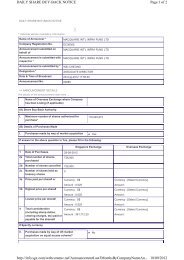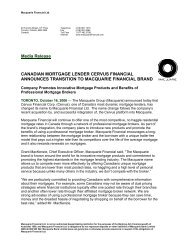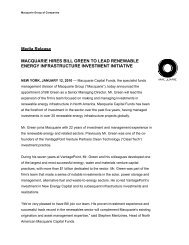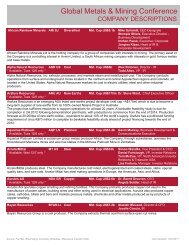Macquarie International Infrastructure Fund Limited SGX Quarterly ...
Macquarie International Infrastructure Fund Limited SGX Quarterly ...
Macquarie International Infrastructure Fund Limited SGX Quarterly ...
Create successful ePaper yourself
Turn your PDF publications into a flip-book with our unique Google optimized e-Paper software.
Unaudited Financial Report=For the quarter ended 30 September 2007Commentary on Competitive Industry Conditions<strong>Infrastructure</strong> as a sector has grown rapidly. An estimated 2% of GDP, or around US$800bn, is spent on infrastructureinvestment and maintenance annually. As an indicator of the sector’s growth, the total market capitalisation of the<strong>Macquarie</strong> Global <strong>Infrastructure</strong> Index, a proxy for listed global infrastructure, has grown from US$465bn since 2000 toUS$1,785bn in March 2007.MIIF is the flagship Asian listed infrastructure fund of the <strong>Macquarie</strong> Group (<strong>Macquarie</strong>). MIIF benefits from <strong>Macquarie</strong>'sinfrastructure expertise in tracking new opportunities and acquiring infrastructure assets in diversified sectors atcompetitive prices around the world, but with an increasing focus on Asia.The attractiveness of Asia as an investment destination for infrastructure is driven by the following factors:Demographic changeRising populations and demographic change put pressure on existing infrastructure and create demand forincreased investment. According to World Bank estimates, the urban population in East Asia and the Pacific regionis projected to increase by 500m over the next 20 years.This growth will place tremendous pressure on existing urban infrastructure, especially on basic services such aselectricity generation, telecoms, water and sanitation. The World Bank estimates that infrastructure investment ofclose to US$180bn a year will be required for the East Asia and the Pacific region alone.Economic GrowthSustainable economic growth over the long term requires investment in new infrastructure and maintenance ofexisting infrastructure assets.Strong economic growth, measured by increasing GDP and increasing wealth among consumers, is likely to spurinfrastructure investment, particularly in developing countries. Higher incomes bring increased demand for a betterquality of life, enhanced environmental and government services, and the extension of municipal services tocommunities.According to the World Bank, Asia grew by 4% in 2004 and is expected to grow by a compounded annual rate of10% by 2014. GDP growth will drive demand for infrastructure investment and sustainable growth can only beachieved through continued investment.<strong>Infrastructure</strong> InvestmentsThe Asian Development Bank 14 estimates that in East Asia alone, the expected infrastructure service needs will beUS$165bn annually over the next five years. This is approximately 6.2% of the region’s annual GDP. Theseestimates take into account both new investments and maintenance of existing assets. To meet these needs, it isestimated that 65% of the expenditure would have to be new investment.Governments, often faced with growing deficits and other demands on spending, are struggling to keep up with thegrowing demand for infrastructure investment. While demand continues to rise, government spending oninfrastructure has declined, creating a widening investment gap.According to World Bank estimates, developing countries must spend an estimated 7% of GDP annually, in order toservice infrastructure requirements for both new investment and operations and maintenance of existinginfrastructure. Since developing countries today spend an average of 3-4% of GDP on infrastructure annually, theyface a substantial investment gap.The widening investment gap has opened the door for private involvement in infrastructure provision. Governmentsare increasingly allowing private capital to flow into sectors which were traditionally under the complete purview ofthe government.Private investment in infrastructure has taken three routes of full private provision, public-private partnership and privatefinance initiative schemes. According to the World Bank, private investors contributed US$580bn in more than 1,900infrastructure projects in developing countries from 1990 to 1999.14http://web.worldbank.org/WBSITE/EXTERNAL/COUNTRIES/EASTASIAPACIFICEXT/EXTEAPINFRASTRUCTURE/0,,contentMDK:20700727~pagePK:64168445 Asian Development Bank<strong>Macquarie</strong> <strong>International</strong> <strong>Infrastructure</strong> <strong>Fund</strong> <strong>Limited</strong> Page 29
















